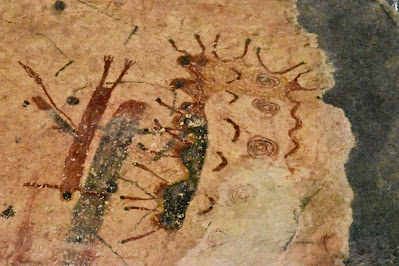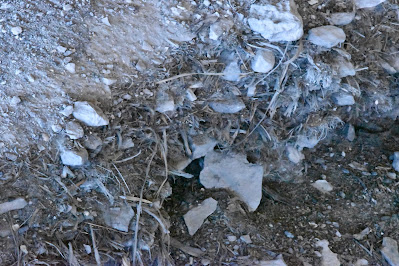Musings as we move
So many thoughts about where we’ve been and all that we have experienced as we are again on the road. Snouts pointed southward, we depart Del Rio and anticipate arriving gulfside by day’s end.
A few deer stand expectantly at the roadside and wisely choose not to cross as we and trucks pass by. We’ve seen many of the small whitetails that abound in Texas; they seem tiny in comparison to Arizona’s mule deer.
The method by which the animals are taken here is so odd, to my way of thinking, but really, how else could it be done. Everywhere are deer feeders with high stilted blinds nearby. Not what we think of as hunting; however, it does not seem feasible to track or stalk game in the mostly impenetrable thorny brush that covers the landscape.
Deer are not the only ones wanting to cross; as we traverse this vast expanse, we are seeing a plethora of border patrol units being assisted by National Guard soldiers in camouflage uniforms and armored vehicles stationed every mile along the route.
No entry, guided tours only . . .
When we are in Texas, it requires a mindset adjustment; we are so accustomed to back county exploration at will. Here, though, all is private land, closed and locked off to access, which leads me to some of our activities: tours to prehistoric rock art sites.
We embarked on two of them on consecutive days, much to the dismay of my leg muscles. The White Shaman site lies 250 feet deep in a canyon overlooking the Pecos River on private ranch land. Witte Museum docents lead tours to it weekly; our chosen day followed a night of sustained winds that had us rockin’ and rollin’ in our tiny abode. There was no letup as day dawned so cold that I searched for every layer of clothing I could find, most of which I shed before the return trek. I’m incredulous that they take random folks down that trail: it was very steep and with precarious footing, pretty much impassable without the handhold chains in many places. As we dropped down the steep cut in the cliff face, my thoughts turned to the anticipated climb back out.
The so-called White Shaman pictograph dominates the site and is stylized in a modern sculpture that has been placed high above.
The art has been highly degraded by eons of weathering; however, its age has been estimated at more than 2,500 years, so really, it is miraculous that it exists at all.
In my opinion, the speculation about possible meanings and interpretations of the two sites we saw are a bit on the fanciful side. We seem to have a need to understand those hieroglyphs, but surely it is not possible given such completely different cultures.
This span across the Pecos is the highest bridge in Texas. We could see it from our perch at the petroglyph site. In fact, the White Shaman site was discovered by folks in a boat.
With a little anticipatory dread on my part, we set off the second day for the Fate Bell Shelter rock art site in Seminole Canyon. That trek was more civilized with built steps in places, and was a far more picturesque walk, and it also began with a modern sculpture - "Enduring Spirit".
The Fate Bell Shelter (it's named after the ranch owner) was far larger and had been an inhabited overhang unlike White Shaman. There had been extensive pot hunting before it came under the auspices of Texas State Parks. Within the mounds left by treasure hunters, there were ample pieces of ruined yucca mats woven by those who lived there so long ago, as seen in the second photo.
Some paintings and photographs of the glyphs done in earlier years help to see what is there but now faded.
We were told that the petroglyphs in these shelters are unique to the trans-Pecos region. They were certainly different from any that we have seen elsewhere.
The Pecos, birds, a goat, sheep . . .
In the course of our wanderings in that area, we made our way down to the Pecos where we were surprised to find a small flock of white pelicans. Added to that, the crested caracara was our only other addition to the bird list. We saw a large number of caracaras, mostly individuals; they are a most impressive large bird.
I took this warning about illegals seriously; we saw no suspicious activity, but remained aware as the sign admonished.
We spotted a large goat that had been trapped in river bottom mud and reported it to a ranger. We hope they were able to extricate it, but it would have been a tricky proposition to get to it without also sinking.
I was surprised to see that numerous herds of sheep are grazing dispersed throughout that desert. I am accustomed to flocks being shepherded assisted by dogs, but these appear to be widespread and unaccompanied.
We tried our hands at fishing in Lake Amistad again with better but still mediocre results. It was lovely being out there watching the moon rise over the water and hearing the calls of loons as they bobbed out on the surface.
A small world . . .
Once again, we were reminded of the connections that are to be found virtually everywhere. We became acquainted with an Arkansas couple in the RV park, and learned that she hailed from Littlefield, Texas, the final home of my great & great great grandmothers, Julia Kelley and Mattie Winans. Not only that, but we had mutual friends there: the family that saved Julia’s Bible after her demise, and who sent it to me. They are the same folks we stayed with on our way to Waco last June. And to top it off, they are also genealogists and Gayla’s family surname, Peel, is the same as my cousin Luther’s wife; there very well may be a relationship.
































1 comment:
Very interesting about the hieroglyphs!!
Post a Comment